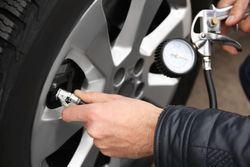Do’s & Don’ts of Driving on Gravel

Whether or not your car was built for off-road use, driving on gravel requires more care than driving on asphalt or concrete. You have to consider maintenance and driving style, from the tire treads to your steering. Here’s some advice for safely driving on a gravel surface.
Do:
Adjust tire pressure.
Slightly lowering the air pressure of your tires increases the surface area they cover, which improves traction. More traction gives you more stability on gravel roads.
 Plus, the softer tires won't be in as much danger from punctures. However, don’t make them too soft, which will make steering harder.
Plus, the softer tires won't be in as much danger from punctures. However, don’t make them too soft, which will make steering harder.
Maintain distance from others.
Try to keep a safe distance from any vehicles in front of you. Give yourself several seconds to respond to anything that might happen, such as if their brakes fail on an uphill section or they lose control of the wheel.
Staying away also prevents dust clouds from affecting visibility. You'll also be less likely to get hit by stray pebbles kicked up by the other car.
Don't:
Drive too fast.
Even if you've improved the traction on your tires for more stability, you should still pay close attention to your speed. Rocks, potholes, and other debris can damage your car if you drive over them, and high speed can amplify that impact. Driving too fast also makes it harder to maneuver and brake, and also makes you prone to skidding.
Go off the beaten track.
If you're not familiar with the gravel road you're on, try to follow tire tracks. The areas that have been used by other drivers before you are more likely safer to drive over. Also, avoid parts of the road that are so rugged that they could easily cause damage to the undercarriage of your vehicle.
If you have tire or brake problems after driving on gravel, contact Privitt Auto Service Center in Columbia, MO. They've been providing auto repairs and car diagnostic services since 1963. If you'd like to schedule an appointment or have other inquiries, message them on their website or call (573) 449-7941.
About the Business
Have a question? Ask the experts!
Send your question

